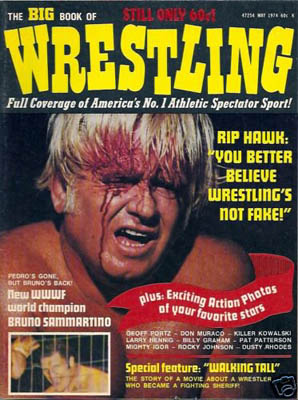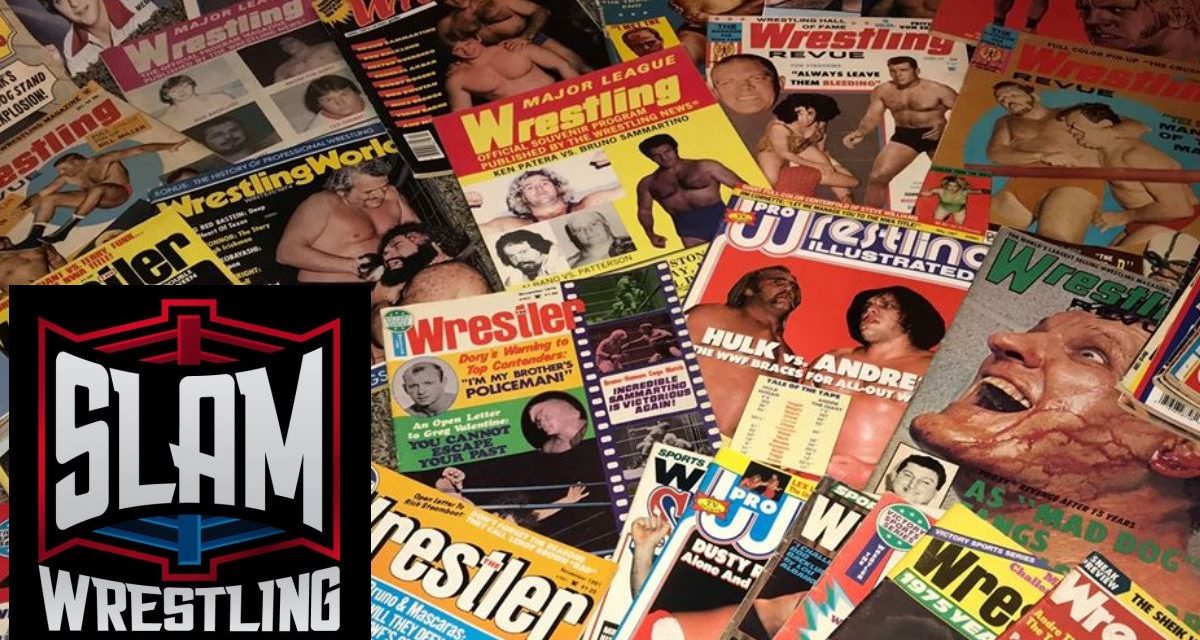During his thirty years as a pro wrestler, Rip Hawk piled up enough championship belts, main event appearances, and road stories to last a lifetime.
But one of his sheer joys came long after he stopped snarling at crowds in places like St. Louis and the Carolinas. In the 1990s, the director of the YMCA in his home of Hereford, Texas, secured his services as a wrestling coach, and Hawk became as proud of his charges as he did of his pro career, sending several wrestlers to the Junior Olympics and to college on athletic scholarships.

A few years ago, four of them signed a letter to Hawk, born Harvey Evers in 1930, and he recounted party of it in an interview with SLAM! Wrestling: “Without you being there by our side and believing in us we would not have been the champions we are today. We may not always get the gold but what we have is irreplaceable. You are the gold to us,” they said.
And that touched the heartstring of a guy who did his dead-level best to beat up fan favorites like Johnny Weaver and Cowboy Bob Ellis for years. “What more could a coach ask for?” he asked. “When they can write you a letter like that it brings tear to your eye. As Ike Eakins would say, it would bring a tear to a glass eye. Well, I guess I got a glass eye.”
Hawk, who died December 22 at 82, after a series of heart-related ailments in recent years, was best known as the tag team partner of Swede Hanson in Jim Crockett Sr.’s Charlotte, N.C.-based promotion in the 1960s and 1970s. And he’s more known to modern fans as Ric Flair’s first teammate, when he took a wild young man to his side as a pretend “nephew” in 1974.
“Ric was a real case, always very flamboyant, always wanting to be noticed. Some of the promoters got upset with him — don’t do this, don’t do that. I was like that myself. But he was one of the new breed, coming in a wild era and he proved himself.”
But the ex-Marine’s career went far beyond those affiliations. He was a main event star in St. Louis at the turn of the 1960s, feuding with on-air personality Joe Garagiola. By his own admission, he “raised hell” in Australia, California, Texas and elsewhere as “The Profile,” Rip Hawk. He held more than a dozen tag team titles, was a four-time eastern State champion, and held the Texas heavyweight belt in 1963.
He also gave big breaks, personally and professionally, to wrestlers such as “Beautiful” Bruce Swayze, Weaver, and Jerry Brisco, whom he befriended in Australia and brought to Crockett’s promotion.
“So I’m eternally to him because of his business knowledge inside and outside the ring,” Brisco said. “Rip was a teacher; he was one of those old Marine guys that was a pretty gruff guy to some people but he wasn’t a selfish guy or anything like that. If he took a liking to you, he took you under his wing and he wouldn’t let you escape. He’d drill it, drill it, drill it, like they did in the Marines.”
Evers was born in June 1930 in a small Indiana town and raised was raised in Ohio. His father was a minor league pitcher in the New York Yankees organization, but elbow problems ended his career. It was a rough life — his family had no electricity, no indoor plumbing, and got by with a few cows and chickens on a farm. His mother landed a job at $12 a week, which was like a fortune during the Depression. “We had to get our water out of the pump, the well out in the back and carry it in, and when we needed a bath we had a big old washtub that we used to fill water in and heat it up. That was our bath,” he said.
It wasn’t long before he found his life’s calling, though. A sergeant at a Police Athletic Club got him into wrestling, bought him a pair of wrestling shoes, and he was off and running. He turned pro around his 18th birthday for Ohio promoter Cliff Maupin, and landed in Chicago, wrestling and training for about a year with Karl Pojello, the manager of The French Angel (Maurice Tillet), at a camp of future all-stars such as Johnny Valentine, Farmer Marlin and Man Mountain Dean Jr.
“We used to work out hard, really hard. We’d get up in the morning, do our running, then we’d lift weights, then we’d take a break, then we’d get on the mat. We’d take turns wrestling sometimes four and five hours a day just wrestling, not counting the other stuff. Well, by the time evening got there, we were so tired, we didn’t want to do anything. We’d just go to our cots and flop down and sleep after we ate. But it was quite an experience,” he said.
Hawk worked briefly in New York under his real name before hooking up with the Marines, as a way of avoiding being drafted in the Army at the time of the Korean War. Some friends had told him their Marine training saved their lives in places like Saipan and Guadalcanal, and Hawk never forgot his service. “I was very proud that I signed up for the Marine Corps. I served, did my thing. I was very fortunate.” Discharged in January 1954, he brushed a suggestion from his commanding officer that he stay in the military, telling him he thought he could do better in wrestling.
Hawk — the nom de guerre name was suggested by a promoter — started to make a name for himself in Atlanta, where his first big payday was against Fred Blassie. “He was like most of the old-timers, we were all characters. If you weren’t a character in this business, you may as well slam the door in your own face. You had to be a character to the people in the ring; out of the ring you had to live your part to be successful,” he said.
He got his first national exposure in St. Louis and its famous Wrestling at the Chase TV program, making the cover of Parade magazine with Joe Tomasso. “In St. Louis, in those days, wrestling was such big time people used to gamble on it. The police used to have to block your way, block off the fans when you got to the arena and keep them from getting to you. All they wanted was autographs on the way in. On the way out, they wanted to punch you out,” he said.
In St. Louis, legendary heel Bill Longson, who owned part of the promotion, passed on his piledriver to Hawk, and it became his finisher for the rest of his career. His bloody bouts with Ellis drew big crowds to Kiel Auditorium, but Hawk never forgot to have a little fun in the ring. One night, he purchased a little handheld buzzer that vibrates wildly when you shake hands with somebody.
“I was wrestling Cowboy Bob Ellis. He was kind of goofy,” he laughed. “So we’re wrestling, he got me in his bulldog headlock and started to take off with me and I hit him right in the ass with that buzzer. He let go of me and fly across the ring all by himself. Well, Swede and I took advantage of that and beat the shit out of him. To me, that was funny. Ellis didn’t appreciate that. I got him good.”
Hawk went to the Carolinas in 1960 and was never shy about saying he helped pump life into a moribund promotion. There, he tapped Hanson, a ex-Golden Gloves fighter from New Jersey, as his partner in a heavy tag team territory. They fought Weaver and George Becker for years in every conceivable kind of match and earned their stars as one of the greatest tag teams of all time.
“That Swede and I had more fun going throughout different countries than any man deserves to have, from Australia to Japan, Hong Kong, Singapore, Canada, you name it we had the fun,” Hawk said in a 2008 interview.
“One night we flew back from Tokyo and we were supposed to wrestle in Richmond, Va. The plane was late, we rushed off the plane and got a cab to go the arena and we were changing clothes in the cab. He’s 300 pounds and I was 250. Here’s two big clowns changing clothes in the back of a cab. The driver couldn’t believe what we were doing. He dropped us off, we paid him and we were ready to wrestle. The fact that we were tired and had been drinking on the way back had nothing to do with it. We knew we had to be in that ring and we knew we had to perform and we did.”
Hawk left his comfort niche in the Crockett business in 1975 over differences with booker George Scott. He hooked up with Eddie Einhorn’s International Wrestling Alliance, which promised guarantee salaries, national publicity, and first-class accommodations. But he got into a rift with IWA promoter Pedro Martinez — “I was going to shoot him one night in South Carolina. He shorted me on my payday and he sent the money with one of his stooges. … ‘You tell that son of a bitch I’m coming to shoot him.’ I got my gun out of my bag and I guess he warned Pedro and he took off. I was just going to shoot him in the leg.” Hawk ended up in Washington, D.C., talking to U.S. senators about the IWA at the request of Jim Barnett, the promoter who’d booked him in Australia, as the Einhorn group gradually went out of business.
After wrestling, Hawk settled in west Texas with his second wife, whom Hanson called “Lee-tle Linda,” because of his Spanish background. He spent a lot of time at the ranch of his daughter and son-in-law that is home to about 2,000 head of cattle occasionally taking potshots at nearby prairie dogs. “Lots of farmers put poison out there because the prairie dogs make all these holes then the cattle step in them and break their legs and then they’re no good,” he said.
And, in addition to teaching wrestling, he lived for the rodeo exploits of his grandson Yaegar; you couldn’t talk to Hawk in recent years without hearing the sheer delight in his voice about his grandson’s calf-roping or steer riding successes.
Reflecting on his career a few years ago, he said. “I had an especially good life when I had children and grandchildren and I love life. But we all have to go sometime. Like I say, I don’t want to be morbid but please remember that I lived a good life. It was a hard life, but it was good.”
A funeral service will be at 1 p.m. Dec. 27 at the First Baptist Church of Hereford, Texas, with Ken Varner officiating. Rix Funeral Directors of Hereford is in charge of arrangements.
Steven Johnson enjoyed interviewing Rip Hawk dozens of times in the last eight years and SLAM! Wrestling will have more on his career and his colleagues in the coming days.

